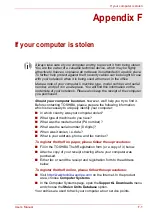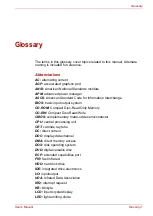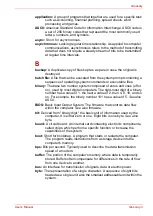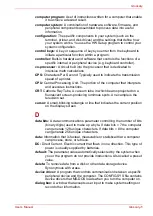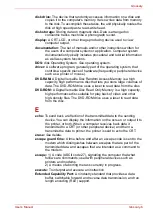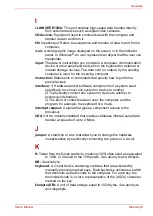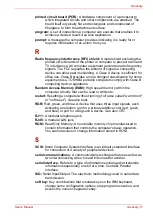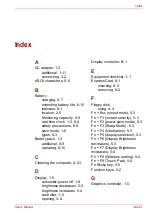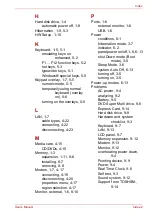
User’s Manual
Glossary-11
Glossary
printed circuit board (PCB):
A hardware component of a processor to
which integrated circuits and other components are attached. The
board itself is typically flat and rectangular, and constructed of
fiberglass, to form the attachment surface.
program:
A set of instructions a computer can execute that enables it to
achieve a desired result.
See also
application.
prompt:
A message the computer provides indicating it is ready for or
requires information or an action from you.
R
Radio frequency interference (RFI) shield:
A metal shield enclosing the
printed circuit boards of the printer or computer to prevent radio and
TV interference. All computer equipment generates radio frequency
signals. The FCC regulates the amount of signals a computing
device can allow past its shielding. A Class A device is sufficient for
office use. Class B provides a more stringent classification for home
equipment use. TOSHIBA portable computers comply with Class B
computing device regulations.
Random Access Memory (RAM):
High speed memory within the
computer circuitry that can be read or written to.
restart:
Resetting a computer without turning it off (also called "warm boot"
or "soft reset").
See also
boot.
RGB:
Red, green, and blue. A device that uses three input signals, each
activating an electron gun for a primary additive color (red, green,
and blue) or port for using such a device.
See also
CRT.
RJ11:
A modular telephone jack.
RJ45:
A modular LAN jack.
ROM:
Read Only Memory: A nonvolatile memory chip manufactured to
contain information that controls the computer's basic operation.
You cannot access or change information stored in ROM.
S
SCSI:
Small Computer System Interface is an industry standard interface
for connection of a variety of peripheral devices.
serial communications:
A communications technique that uses as few as
two interconnecting wires to send bits one after another.
serial interface:
Refers to a type of information exchange that transmits
information sequentially, one bit at a time. Contrast: Parallel
interface.
SIO:
Serial Input/Output. The electronic methodology used in serial data
transmission.
soft key:
Key combinations that emulate keys on the IBM keyboard,
change some configuration options, stop program execution, and
access the numeric keypad overlay.



